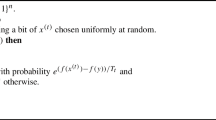Abstract
Simulated Annealing is a family of randomized algorithms used to solve many combinatorial optimization problems. In practice they have been applied to solve some presumably hard (e.g., NP-complete) problems. The level of performance obtained has been promising [2,5,6,14]. The success of this heuristic technique has motivated analysis of this algorithm from a theoretical point of view. In particular, people have looked at the convergence of this algorithm. They have shown (see e.g., [10]) that this algorithm converges in the limit to a globally optimal solution with probability 1. However few of these convergence results specify a time limit within which the algorithm is guaranteed to converge (with some high probability, say). We present, for the first time, a simple analysis of SA that will provide a time bound for convergence with overwhelming probability. The analysis will hold no matter what annealing schedule is used. Convergence of Simulated Annealing in the limit will follow as a corollary to our time convergence proof. In this paper we also look at optimization problems for which the cost function has some special properties. We prove that for these problems the convergence is much faster. In particular, we give a simpler and more general proof of convergence for Nested Annealing, a heuristic algorithm developed in [12]. Nested Annealing is based on defining a graph corresponding to the given optimization problem. If this graph is ‘small separable’, they [12] show that Nested Annealing will converge ‘faster’. For an arbitrary optimization problem, we may not have any knowledge about the ‘separability’ of its graph. In this paper we give tight bounds for the ‘separability’ of a random graph. We then use these bounds to analyze the expected behavior of Nested Annealing on an arbitrary optimization problem. The ‘separability’ bounds we derive in this paper are of independent interest and have the potential of finding other applications.
Similar content being viewed by others
References
Bollobás, B. (1985), Random Graphs, Published by Academic Press.
ElGamal, A., and Shperling, I. (1984), Design of Good Codes via Simulated Annealing, List of Abstracts, Workshop on Statistical Physics in Engineering and Biology, Yorktown Heights, NY.
Feller, W. (1966), An Introduction to Probability Theory and Its Applications, Volumes I and II, Published by John Wiley and Sons.
Garey, M. and Johnson, D. (1979), Computers and Intractability: A Guide to the Theory of NP-Completeness, Published by W.H. Freeman & Co., New York.
Golden, B.L. and Skiscim, C.C. (1986), Using Simulated Annealing to solve Routing and Location Problems, Naval Research Logistics Quarterly, 33, pp. 261–279.
Johnson, D.S., Aragon, C.R., McGeoch, L.A. and Schevon, C. (1987), Optimization by Simulated Annealing: An Experimental Evaluation (Part I), Preliminary Draft, AT & T Bell Labs., Murray Hill, NJ.
Kirkpatrick, S., Gelatt, C.D. and Vecchi, M.P. (1983), Optimization by Simulated Annealing, Science.
Lipton, R.J. and Tarjan, R.E. (1980), Applications of a Planar Separator Theorem, SIAM J. Comput. 9(3).
Lipton, R.J. and Tarjan, R.E. (1979), A Planar Separator Theorem, SIAM J. Appal. Math. 36(2).
Mitra, D., Romeo, F. and Vincentelli, A.S. (1986), Convergence and Finite-Time Behavior of Simulated Annealing, Advances in Appal. Probability.
Rabin, M.O. (1976), Probabilistic Algorithms, in: Traub, J.F., ed., Algorithms and Complexity, Academic Press, New York, 1976. pp. 21–36.
Rajasekaran, S. and Reif, J.H. (1988), Nested Annealing: A Provable Improvement to Simulated Annealing, Proc. ICALP 1988. Also submitted to Theoretical Computer Science.
Solovay, R. and Strassen, v. (1977), A Fast Monte-Carlo Test for Primality, SIAM J. Computing 6, 84–85.
Vecchi, M.P. and Kirkpatrick, S., Global Wiring by Simulated Annealing, Technical Report, IBM Thomas J. Watson Research Center, New York, pp. 10598.
Author information
Authors and Affiliations
Rights and permissions
About this article
Cite this article
Rajasekaran, S. On Simulated Annealing and Nested Annealing. Journal of Global Optimization 16, 43–56 (2000). https://doi.org/10.1023/A:1008307523936
Issue Date:
DOI: https://doi.org/10.1023/A:1008307523936




